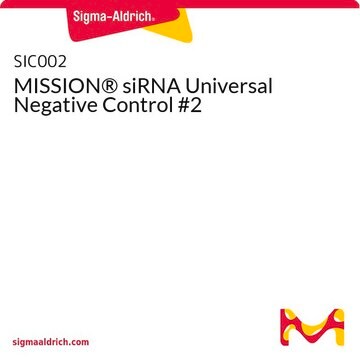SHK001
MISSION® Human Kinase Lentiviral shRNA Pool
About This Item
Productos recomendados
Línea del producto
MISSION®
Nivel de calidad
Condiciones de envío
dry ice
temp. de almacenamiento
−70°C
Categorías relacionadas
Descripción general
Sigma-Aldrich has a long-standing expertise in pooled lentiviral screening spanning whole genome and custom pool offerings. Due to the popular demand of the kinase gene panel, we are proud to offer an off-the-shelf, ready-to-use shRNA kinase pool optimized to meet researchers′ needs. This pooled library targets the human kinome, a collection of approximately 745 genes commonly associated with development and disease, with an average of 12.6 shRNA clones per unique kinase gene. More importantly, this shRNA pool contains important enrichment, depletion, and non-target controls so you can be confident in your results, and reduce the likelihood of false positives or negatives. The lentiviral format allows for stable integration, selection, and enrichment of transduced cells, allowing researchers to functionally screen hundreds of kinase genes for a fraction of the time and cost of screening arrayed clones.
Whether you are interested in small molecule screening or in defining developmental signaling pathways, Sigma′s shRNA human kinase pooled lentiviral library offers researchers a high throughput solution to uncover novel kinase targets, especially when essential and lethal genes are important.
Differences "between hit genes called by CRISPRi and RNAi are not necessarily an indication of technical shortcomings of either method, but can also guide new biological discoveries. The difference [lies] in the mode of action of CRISPRi and RNAi: Whereas CRISPRi targets entire transcription units, including alternative splice isoforms and embedded ncRNAs, RNAi targets mature transcripts and thus differentiates between different products processed from the same primary transcript. Parallel CRISPRi and RNAi screens can reveal novel transcript functions in cases where CRISPRi and RNAi phenotypes for reagents designed to target the same gene product differ." From Kampmann et. al. PNAS (2014) 112(26): June, 2015.
Please also see our Human Kinase Lentiviral CRISPR Pool for more information on how to complement your RNAi screen(s).
Aplicación
Características y beneficios
Protein kinases are among the largest and most well studied gene families. Protein phosphorylation plays an essential role in intercellular communication in eukaryotic organisms by mediating signal transduction during development, transcription, immune response, metabolism, apoptosis, and cell differentiation. Aberrant regulation of kinases plays a causal role in many diseases, and the study of these proteins and their functions will contribute to the discovery and development of new therapeutics.
The Sigma shRNA Human Kinase Lentiviral Pooled Library contains:
- Over 9,400+ lentiviral shRNA clones to knockdown over 745 human kinase genes
- High clone coverage (average of 12.6 per gene) increases the statistical strength of your hit analysis
- Numerous built-in enrichment and depletion clones allow researchers to confidently gauge the success of their pooled screening experiments (enrichment controls: PTEN and NF1. Depletion controls: ANAPC2, ANAPC4, and ESR1).
- The pool contains over 50 non-targeting control shRNAs as normalization standards (including GFP, RFP, LacZ, luciferase, and scrambled controls)
Componentes
Principio
Lentiviral-based particles permit efficient transduction and integration of the expression cassette into differentiated and non-dividing cells, such as neurons and dendritic cells. Self-inactivating replication incompetent lentiviral particles are generated in producer cells (HEK 293T) by co-transfection with compatible packaging plasmids. In addition, the lentiviral transduction particles are pseudotyped with an envelope G glycoprotein from Vesicular Stomatitis Virus (VSV-G), allowing transduction of a wide variety of mammalian cells.
Otras notas
Información legal
Código de clase de almacenamiento
12 - Non Combustible Liquids
Clase de riesgo para el agua (WGK)
WGK 3
Punto de inflamabilidad (°F)
Not applicable
Punto de inflamabilidad (°C)
Not applicable
Certificados de análisis (COA)
Busque Certificados de análisis (COA) introduciendo el número de lote del producto. Los números de lote se encuentran en la etiqueta del producto después de las palabras «Lot» o «Batch»
¿Ya tiene este producto?
Encuentre la documentación para los productos que ha comprado recientemente en la Biblioteca de documentos.
Los clientes también vieron
Artículos
When shRNA is delivered using lentiviral vectors, the sequence encoding the shRNA is integrated into the genome and the knockdown effect is passed on to daughter cells, continuing gene silencing.
Nuestro equipo de científicos tiene experiencia en todas las áreas de investigación: Ciencias de la vida, Ciencia de los materiales, Síntesis química, Cromatografía, Analítica y muchas otras.
Póngase en contacto con el Servicio técnico







